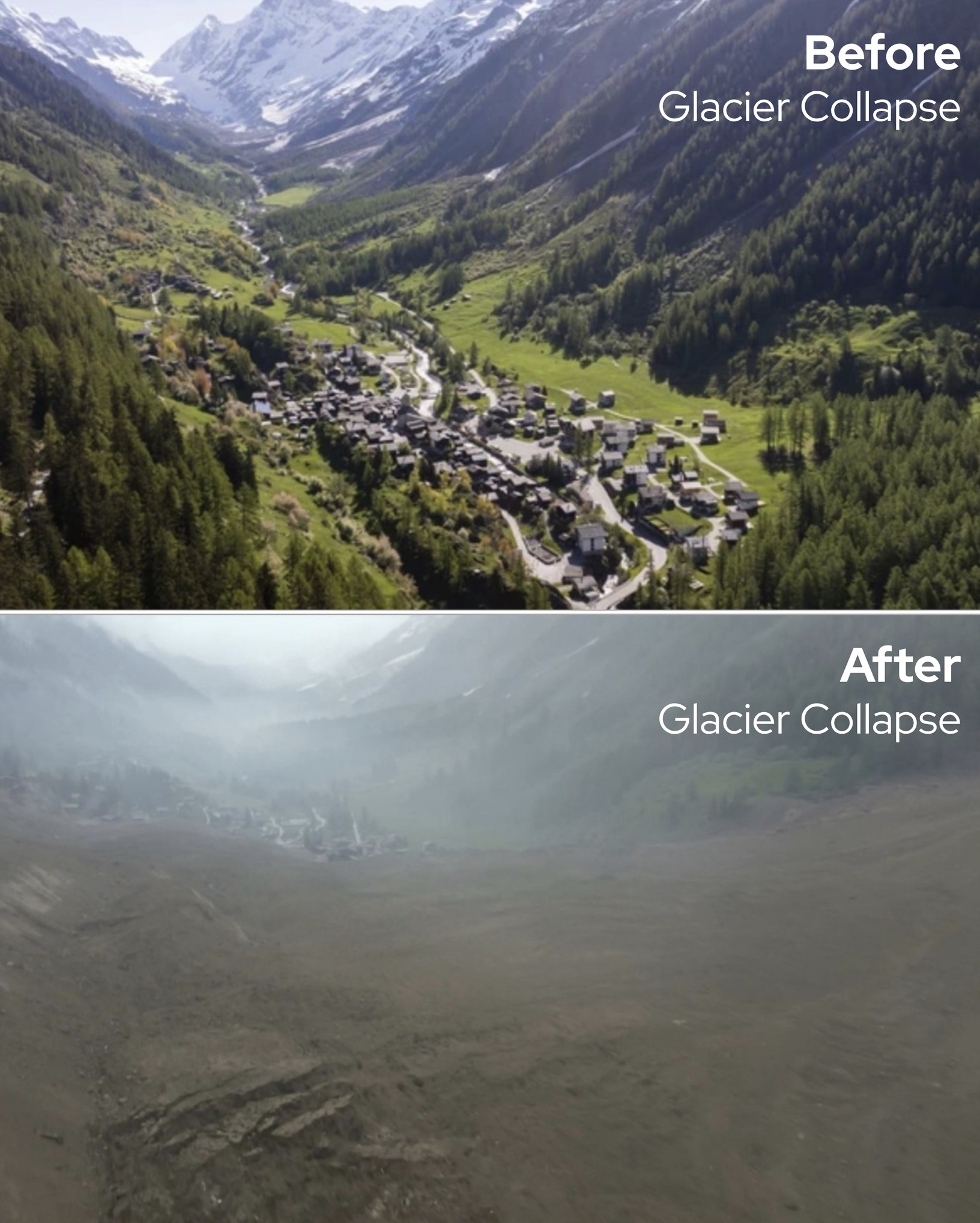On May 28, 2025, Switzerland faced one of the most devastating natural disasters in recent memory, as the picturesque Alpine village of Blatten, located in the canton of Valais, was completely wiped out by a catastrophic glacier collapse. This event serves as a shocking reminder of the accelerating effects of climate change and how even the most serene and tranquil places can be dramatically changed in an instant.
Blatten: A Village Transformed by Tragedy
Blatten, once a peaceful and scenic retreat nestled in the Swiss Alps, was renowned for its traditional wooden chalets, lush slopes, and breathtaking mountain views. For years, it attracted tourists and locals alike, offering a peaceful escape from everyday life. However, in just a few moments, this idyllic setting was reduced to rubble when a massive glacier collapsed, sending torrents of ice, rocks, and water flowing down the valley, obliterating everything in its path. The charming streets, homes, and landmarks that once defined the village were buried under layers of debris, leaving only a wasteland behind.
The stunning “before and after” photos from this disaster show the extent of the destruction — entire areas that were once bustling with life now completely submerged under ice and mud. Roads, houses, and even centuries of history were swept away in minutes, leaving the residents with nothing but memories of their lost homes.
The Scale of the Destruction
The impact of the glacier collapse was nothing short of catastrophic. The powerful debris flow that followed destroyed vital infrastructure, homes, and communication lines. The avalanche of rock and ice temporarily isolated the village, making it difficult for emergency response teams to reach those in need. Despite these challenges, the swift evacuation efforts of local authorities ensured that most residents were able to escape with their lives, although many lost everything — their homes, businesses, and livelihoods — in the blink of an eye.
The sheer force of the collapse left an indelible mark on Blatten’s landscape. What was once a vibrant village now lies buried under tons of debris, with recovery efforts expected to take years. The disaster has left the village facing an uncertain future, as rebuilding will require not only time and resources but also the collective effort of both the Swiss government and neighboring communities.
The Causes of the Glacier Collapse
The glacier collapse in Blatten was not an isolated event; it is part of a larger pattern of extreme weather events and natural disasters that have been increasing due to climate change. Scientists have long warned about the dangers of melting glaciers in the Alps, where rising temperatures are destabilizing mountain slopes and causing glaciers to retreat at an unprecedented rate.
The events leading up to the glacier collapse in Blatten were triggered by a combination of factors, including the rapid melting of ice, recent rainfall, and the destabilization of the glacier. Preliminary investigations suggest that a large section of ice broke loose, mixing with meltwater and rainfall, creating a massive debris flow that devastated the village below. This is just one example of the many climate-related disasters that are becoming more frequent around the world.
As global temperatures continue to rise, the risk of similar events occurring in other regions — such as the Himalayas, Andes, and other mountainous areas — is increasing. Experts warn that this could lead to more frequent glacier collapses, threatening communities in vulnerable regions worldwide.
Emergency Response and Recovery Efforts
In the aftermath of the disaster, Swiss authorities mobilized emergency response teams to assist in the search for survivors and clear the debris. Military units and rescue teams, equipped with helicopters and advanced equipment, worked tirelessly to rescue any trapped individuals and begin the long process of recovery. Neighboring towns opened their doors to displaced residents, offering shelter, food, and essential supplies.
However, the challenge of rebuilding Blatten is monumental. While many residents were fortunate enough to escape with their lives, they now face the difficult task of rebuilding their homes, businesses, and way of life. The damage caused by the glacier collapse has left much of the village in ruins, and the recovery process is expected to take years, requiring significant financial investment, resources, and support from both the government and the international community.
This tragedy also highlights the urgent need for a global response to address the climate crisis. With climate change accelerating at an alarming rate, the destruction caused by natural disasters like the Blatten glacier collapse may become more frequent, affecting communities around the world.
A Global Warning: Climate Change is Here
The Blatten glacier collapse is more than just a local tragedy — it is a global warning about the ongoing impact of climate change. Once considered to be eternal, the glaciers of the Alps are now melting at an unprecedented rate, contributing to rising sea levels and causing natural disasters like the one in Blatten. The collapse has left the village with nothing but debris and a difficult road ahead, but it also serves as a stark reminder of the fragility of our environment.
As climate change continues to alter landscapes and ecosystems, the need for global action has never been more urgent. The Blatten disaster shows that climate change is not a future threat — it is reshaping our world right now, affecting communities across the globe. If we do not act quickly and decisively to address the causes of climate change, similar disasters may become more frequent, threatening not only villages like Blatten but entire regions of the planet.
While the recovery of Blatten may take years, the lessons learned from this disaster can help guide future efforts to protect vulnerable communities from the impacts of climate change. By investing in sustainable practices, supporting climate resilience programs, and addressing the root causes of climate change, we can help ensure that future generations are not faced with the same devastation that Blatten has experienced.
For Further Reading:
- Man Loses 360 Pounds Naturally – Internet Rallies to Support His Next Step
- Tammy Hembrow’s Bikini Photos Stir Controversy – Here’s Why Everyone’s Talking
The Blatten disaster not only highlights the severity of climate change but also emphasizes the importance of urgent action. As the planet continues to warm, we must consider the long-term impacts of our actions and make every effort to mitigate climate change for the safety and survival of future generations.


